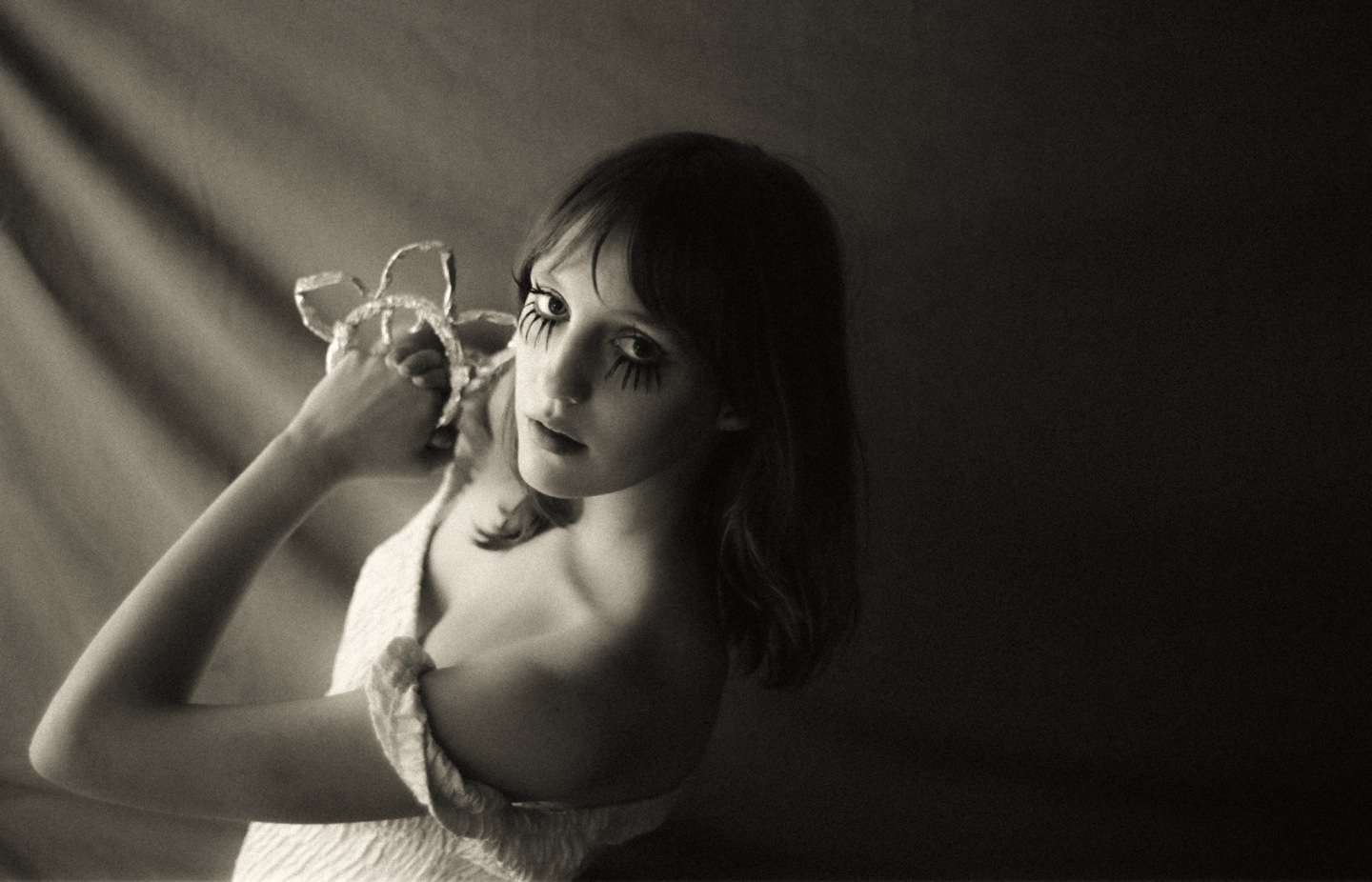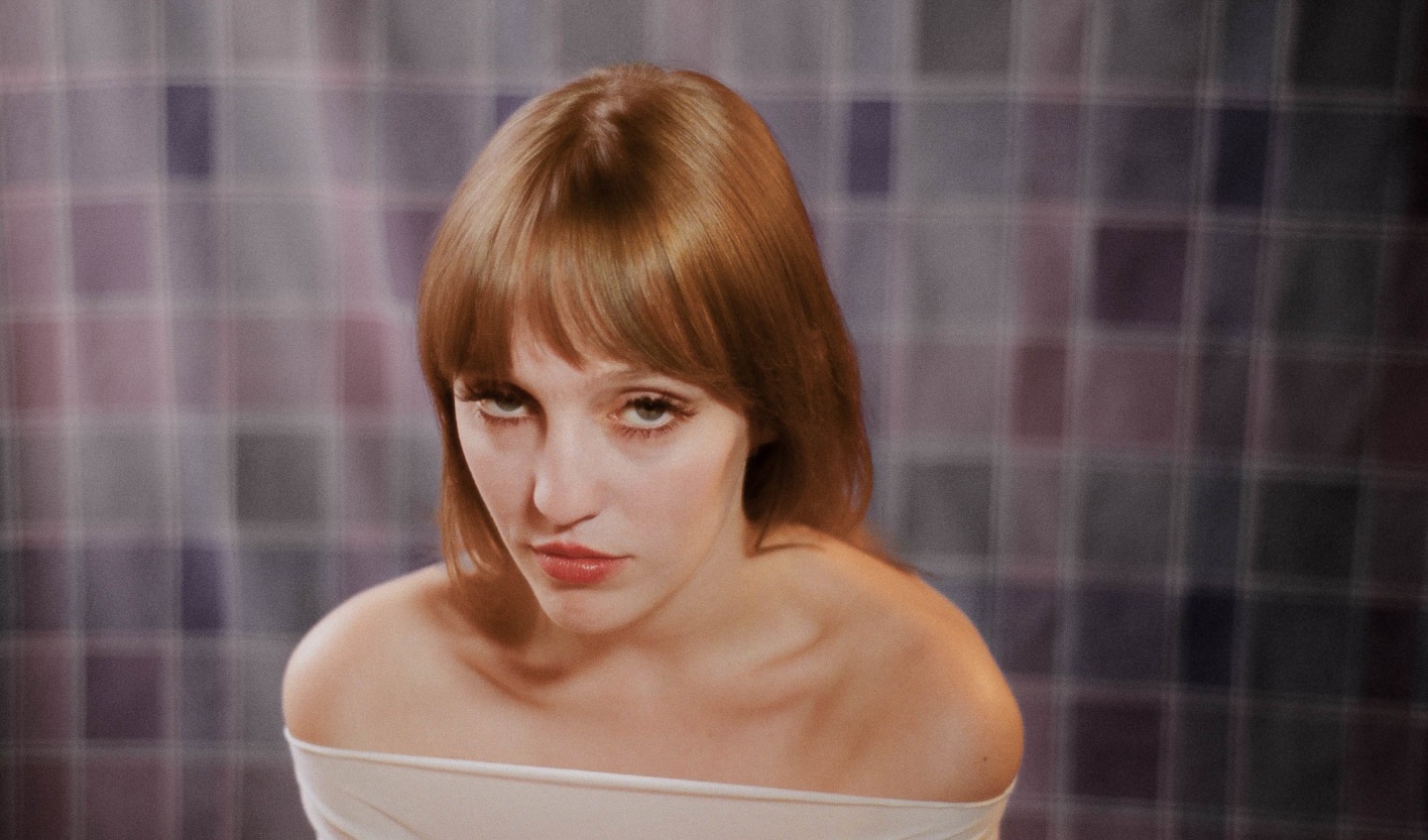 Anastasia Coope. Photo by Grace Conrad.
Anastasia Coope. Photo by Grace Conrad.
Anastasia Coope’s apartment is hard to find. In a city where most every building is sequentially numbered, street-facing, and explorable from one’s personal device, the Brooklyn collective/co-op where the 21-year-old experimental folk artist lives is a rare exception. After locking my bike to a signpost further down her block’s steep incline, I struggle to find the address I’ve been given. Finally, I walk below a mossy power line into an overgrown cove of a driveway, where I’m greeted by Coope, a willowy figure in jeans and a plain white tee.
We climb a set of stairs and walk inside through a vestibule choked by unused bikes, paint cans, and other miscellanea — she points me to a plastic apple she’s particularly fond of. We enter a spacious living room. Here, she ignites a candle and leads me down a hallway draped with dim Christmas lights. “We don’t have electricity,” she jokes.
Coope’s bedroom/studio is a large, open-plan space, its walls adorned with her abstract paintings (a recent Pratt grad, she says she’s “on record” as the school’s “biggest hater of all time”). A giant stuffed cat named Darryl sits in a chair opposite the door.
In light of the music Coope makes, her living situation isn’t all that surprising. Her 2021 debut EP, Seemely, and her first LP, Darning Woman, which arrived at the end of May, are not so much timeless as outside time. Their weird aura — an eerie combination of pastoral folk and medieval hymnal warped into unruly structures — would be discomfiting in any era of human history.
Take the new album’s lead single, “He Is On His Way Home, We Don’t Live Together”: The song opens on a collective moan, with several vocal lines stacked at odd angles to create an unsettling dissonance before Coope’s main melody establishes itself. The childlike, near-whispered repetition of the track’s titular lyric, mirrored by a ghostly piano figure from sonic polyglot Patrick Shiroishi, continues for a full minute. In the background, more Coopes continue to creep in, again layered unevenly.
Finally, her voices dissolve back into inchoate moaning, followed by a brief lyric change that upholds the title’s scansion (“Told me off, you must realize that I am younger”). This too dissipates, as does the piano line, which is replaced by an arrhythmic rattle and jarringly strummed chords from Matthew J. Rolin’s electric guitar. “It’s the best part of the song,” Coope says of Rolin’s bit, which came about through her unlikely, Instagram-initiated friendship with Shiroishi, “and I didn’t even do it.”
Rolin’s solo at the end of “He Is On His Way Home…” is his only contribution to Darning Woman, and Shiroishi returns only once more, on the record’s closing track. Other than that, Coope stands alone.
 Photo by Grace Conrad.
Photo by Grace Conrad.
Coope grew up in Cold Spring, New York, a popular day hike destination for city folk due to its combination of natural beauty and proximity to NYC. As a kid, she spent most of her time outside, daydreaming. “I really enjoyed preschool,” she tells me. “I don’t know if I was hallucinating or what — children have very fantastical views of the world — but I’m nostalgic for that. I’m always trying to get toward that idealized vision of life.”
Through her early teens, she drew incessantly but “visionlessly” and had little interest in music. In fact, it was the musical aspect of theater that ultimately discouraged her from pursuing an acting career. And though she briefly tried the clarinet, she balked at learning to read sheet music. (To this day, she’s skeptical of anyone who claims they can.) “I pretended to know what I was doing, but I would just play one note,” she says. “I don’t know what kind of true passion is born in middle school band.”
“I had to look at what was around me to come up with anything, and that in turn led me to reach for further and more abstracted concepts.”
Outside school, her parents took her to art events across the Hudson Valley, many of which featured music. “Pete Seeger was always around,” she remembers. “It was a very folksy vibe. Everyone’s parents recorded folk albums.”
That energy didn’t bleed into the school system, though. “I had phases with really random pop acts because I was always trying to find a balance,” she says. “There was no exposure to the indie side of music — or if there was, I didn’t see evidence of it.”
The turning point came during the second semester of her senior year of high school, when her parents finally relented to buying her a laptop as she prepared to leave for college. Shortly thereafter, COVID hit.
Coope spent the next year taking online Pratt courses and sheltering in place at an uncle’s usually unoccupied weekend home in Beacon. She’d already started obsessing over music, spending hours on her new computer exploring the catalogs of the artists featured in Amoeba’s “What’s In My Bag” YouTube series and following daisy chains that began with the records these artists had collected in the videos and grew from there: toward ’90s avant-pop bands like Broadcast, whose creative process she imagined as “someone building a house, but they’re obsessed with every single beam being sourced from something”; toward ’50s vocal groups like the Everly Brothers, whose close harmonies unlocked the layering that’s become a central feature of her work, despite her insistence that she’s not a natural harmonizer; toward medieval choral music, where she found hocketing — a technique that appears most prominently on Darning Woman in “Sounds of a Giddy Woman,” in which alternating voices create the illusion of continuity.
“I really enjoyed preschool… I’m always trying to get toward that idealized vision of life.”
“It was an immediate identity shift,” she recalls. “I had so many [free] hours every day, so even if six of them were online classes and being on my phone, it felt natural that the thing I would do when I was like, ‘I have to do something,’ was record music.” In a period of two years, she claims she made about 600 songs.
In those early days, she’d hit record with no plan of what to sing, improvising until she landed on an idea she liked. “It was all just trying to come up with the next word,” she says. “The repetition is either me getting into something or reaching for the next lyric.”
She credits her songs’ nebulous themes, another consistent quality across her work, to the circumstances of their creation: “I didn’t have any life experiences happening. I was alone, so I wasn’t having friend falling outs. I wasn’t meeting people. I had to look at what was around me to come up with anything, and that in turn led me to reach for further and more abstracted concepts.”
“Woke Up and No Feet,” a mid-album cut that’s become Darning Woman’s most popular track, was born from a circular version of this scenario. Its main lyric — “Wonder how hooded boy would be understood if he woke up with no feet” — sprang to mind while Coope was looking at one of her own paintings, which happened to depict a boy in a hood (a recurring image in her art), and realized his feet were mysteriously absent. The line, like so many others on the album, feels plucked from a dark fairytale.
Coope loved watching old Disney movies as a child, though she’s now more enamored with the idea of “things feeling natural but also having flourishes of if the world were a little bit different.”
The core tenets of Coope’s music — repetition, abstraction, magical realism — transport her audience to a sound world that’s eerily familiar but ultimately unlike our own. But the stilted central lyrics of tracks like “Darning Woman” and “Women’s Role in War” evoke convention and antiquity. Yearning for a selectively idyllic past has become increasingly popular with Coope’s generation, but Coope’s old world doesn’t have much to do with current trends toward traditionalism.
She maintains, for instance, that she hadn’t heard the term “trad wife” until after the album was finished, and dismisses the trend as “mostly socialite behavior.” She connects more with the term “homesteader” when I mention it, but distances herself when I bring up its revival’s connection to a group of insidiously far-right social media influencers.
It’s on one hand refreshing and on the other incredibly depressing to note that I, eight years Coope’s elder, am more online than she is. “I don’t have TikTok,” she tells me. “I’m just seeking happiness and a backyard.”
